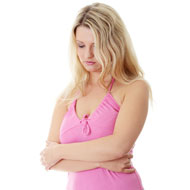- General Articles
- General Pregnancy Questions
- Baby Growth
- Pregnancy Diet
- Miscarriage
- During Pregnancy
- Twin Pregnancy
- Toddler Meals
- Home Remedies During Pregnancy
- Breastfeeding
- Pregnancy Week By Week
- Pregnancy Tests
- Ectopic Pregnancy
- Pregnancy Signs and Symptoms
- Pregnancy Stages
- Potty Training
- Fetal Development
- Preschooler
- Postpartum Depression
- Toddler Illness
- Baby Care
- After Pregnancy
- Molar Pregnancy
- During Delivery
- Beauty and Style
- Pregnancy Clothing
- Preconception
- Fertility
Symptoms, Causes & Treatment for Pain During Ovulation
Ovulation is the process where a mature egg is released from the ovaries. Ovulation occurs around the fourteenth day of an average 28-day menstrual cycle from the time of menarche to menopause except during pregnancy or when breastfeeding. Common symptoms of ovulation include changes in vaginal discharge, breast tenderness, an increase in libido, and a slight decrease followed by an increase in the basal body temperature. In addition to these symptoms, many women complain of ovulation pain before and during the process of ovulation. Also known as 'mittelschmerz', which is German for 'middle pain,' this mid-cycle pain can vary in intensity from one woman to the next.
Some women experience the pain for a few minutes whereas others report an ache in their lower abdomen for up to 48 hours. Ovulation pain in most cases is not a cause for worry. However, if the pain persists for more than three days or is accompanied by other symptoms such as bleeding or nausea, immediate medical attention is required.
What are the symptoms of ovulation pain?
Symptoms of ovulation can include:
- A pain in the lower abdomen
- The pain is usually felt on either the left or the right side depending on which ovary releases the egg during ovulation
- The pain can occur on the right side in one cycle and on the left in the next or remain on the same side for a few cycles at a time
- The pain is felt approximately fifteen days before the next expected period
- Pain can range from a dull ache to a sharp twinge or severe cramps to an uncomfortable pressure in the pelvic region
What Causes the Pain?
While the exact cause for ovulation pain remains unknown, there are two main theories that exist:
- Hormones control the production of egg-containing follicles in the ovaries. In every cycle, only one follicle and egg matures and survives. Experts believe that the stretching and extension of this surviving follicle into the membranes of the ovary causes the ovulation pain.
- Others believe that when the follicle ruptures and releases the mature egg, the uterine lining may get affected or irritated and cause the ovulation pain. When the follicle ruptures, light spotting or bleeding may also follow, which is another sign of ovulation.
Severe pain during ovulation is not normal. In such cases, an underlying medical condition may be causing the pain such as:
- PID or Pelvic Inflammatory Disease
- Infection of the fallopian tubes
- Endometriosis
- Ovarian cysts
- Ovulation Hyperstimulation Syndrome
- Ectopic pregnancy
- Appendicitis
- Gastro-intestinal problems
In order to diagnose whether the cause of ovulation pain is harmless or needs medical attention, a physical examination is conducted along with tests such as blood tests, cervical cultures, vaginal and abdominal ultrasounds or laparoscopic surgery.
How to Treat Ovulation Pain?
If the cause of the ovulation pain is not serious and does not require medical treatment, there are simple ways to reduce the discomfort such as:
- Rest - If the pain is too uncomfortable, putting your feet up and relaxing can help in most cases.
- Medication - Over-the-counter painkillers and anti-inflammatory drugs are often your best bet when it comes to dealing with benign ovulation pain.
- Heat therapy - Hot water bottles placed over the abdomen or a warm bath can do wonders in helping to reduce pain and abdominal cramps.
- Oral contraceptive pills - If the ovulation pain is persistent, birth control pills can help because they stop the process of ovulation. Speak to your doctor about the alternatives.
Read more articles from the Preconception Category.



 7 Must-Haves Before Your Baby Arrives
7 Must-Haves Before Your Baby Arrives Bonding Games for Babies
Bonding Games for Babies DIY Baby Bath Towel Apron
DIY Baby Bath Towel Apron Common Late Pregnancy Fears
Common Late Pregnancy Fears